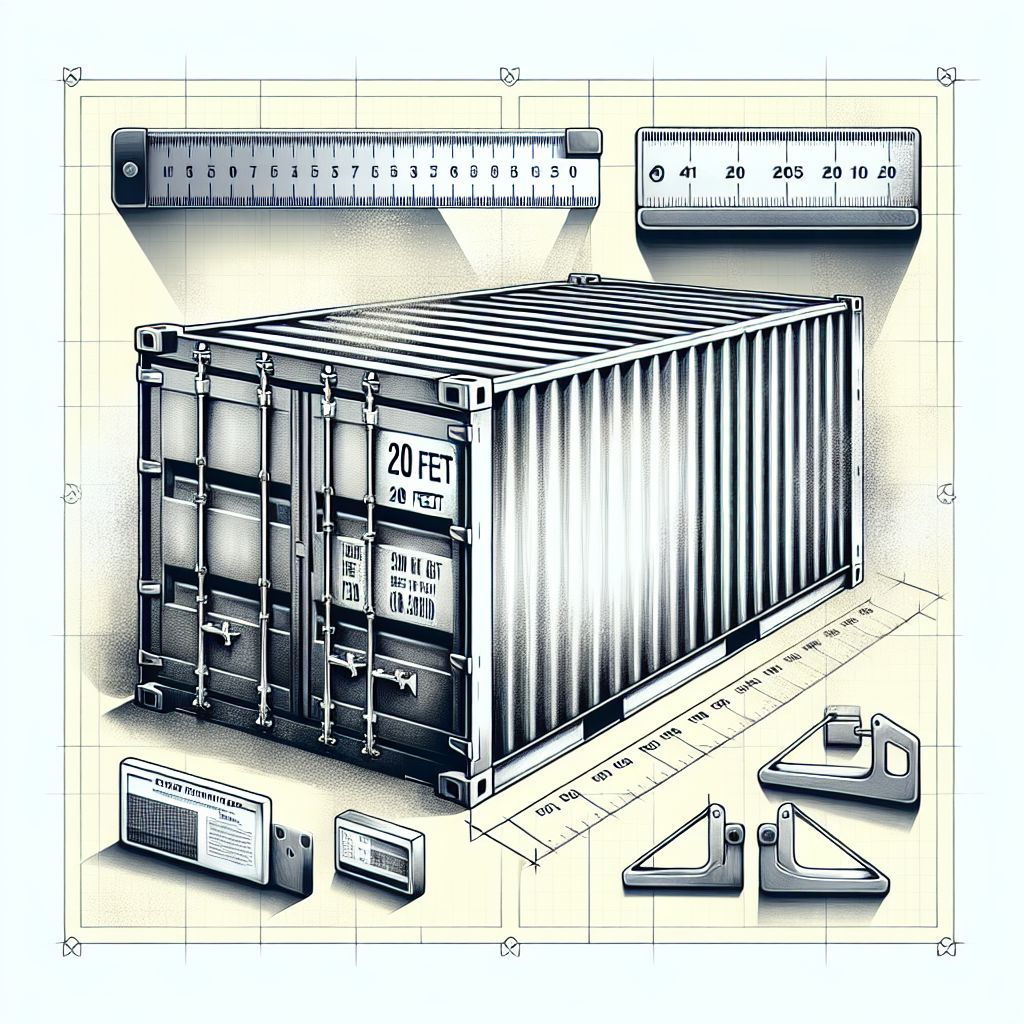
Key Takeaways
- A standard 20ft (6.1m) shipping container has external dimensions of 20ft (6.1m) length, 8ft (2.44m) width, and 8ft 6in (2.59m) height.
- Internally dimensions are 19ft 4in (5.89m) length, 7ft 8in (2.34m) width, 7ft 10in (2.39m) height and usable volume 1,172 cubic feet (33.2 cubic meters).
- The net weight of a standard 20ft container is around 5,071 pounds, and can carry a maximum cargo weight of 62,150 pounds.
- High Cube containers offer an extra foot in height, giving you more space and volume for cargo that is taller or requires stacking.
- Understanding these dimensions is crucial for optimizing packing, adhering to weight limits, and reducing shipping costs.
Unlock the Potential of 20ft Shipping Containers
When it comes to global trade, efficiency is the name of the game. And one of the stalwarts of efficient shipping is the 20ft container, a standardized unit that revolutionized logistics. With its uniform size and capacity, it simplifies the loading, transport, and unloading processes, making it a favorite for businesses and logistics professionals worldwide.
Defining Container Dimensions and Usage
Before we dive into the specifics, let’s establish a foundational understanding of container dimensions. The 20ft container is measured using the imperial system, with the length, width, and height specified in feet. These measurements are crucial as they determine how much cargo you can fit inside and whether your container will fit on the transport modalities you plan to use, such as ships, trains, or trucks.
My Favorite Container Homes Resource
I compared the top 3 Container Home Guides
to discover the ultimate resource!
See my top recommendation here
Comparing Standard and High Cube Variants
Most importantly, there are two main types of 20ft containers: the standard and the high cube. The standard is what you’ll see most often, but the high cube provides additional height for taller cargo. Knowing which one to use is vital for maximizing your shipping efficiency.
The Anatomy of a 20ft Shipping Container
External Measurements
Let’s start with the outside of a standard 20ft container. Picture a box that’s as long as a giraffe is tall, about as wide as a car, and just a bit taller than the average basketball player. These containers are designed to fit snugly onto trailers, rail cars, and in the belly of cargo ships.
Internal Space Considerations
Inside, the container is slightly smaller due to the thickness of the walls. This is where things get interesting because you have to think like a Tetris master to fit your cargo into this space efficiently. The interior dimensions determine how much you can actually pack inside, so knowing these measurements is key to planning your load.
Additional Volume in High Cube Containers
For those who need that extra space, High Cube containers are a game-changer. They stand 9ft 6in tall, providing an extra foot of vertical space compared to standard containers. This means you can stack goods higher or transport taller items that wouldn’t otherwise fit. It’s like having an extra shelf in your closet – it can make a big difference.
Think of it this way: if you’re shipping fluffy toys, that extra foot means you can squeeze in a whole lot more because they can be compressed a bit. But if you’re shipping metal parts, the extra height lets you stack them higher, keeping within the weight limits but maximizing your space.

Maximizing the Use of Container Space
Getting the most out of your container is crucial. You’re paying for the whole space, so you want to use every inch. This means packing smart. Heavy items on the bottom, lighter ones on top, and filling in gaps with smaller items. It’s like playing a 3D puzzle where the goal is to leave no empty space.
Understanding Weight Restrictions
While you might be tempted to pack as much as possible into your container, you have to consider weight limits. Every container has a maximum weight it can safely carry, and going over this limit can be dangerous and illegal. It’s like a backpack – stuff it too full, and not only is it hard to carry, but you risk the straps breaking.
Besides that, overweight containers can incur hefty fines and cause issues with shipping lines and ports. It’s a balancing act between volume and weight – you want to maximize one without exceeding the other.
- Check the maximum gross weight of your container.
- Calculate the weight of your cargo, including packing materials.
- Ensure the combined weight of your cargo and the container’s tare (empty) weight doesn’t exceed the gross weight limit.
Remember, safety comes first. Overloading a container is never worth the risk.
Calculating Usable Volume for Efficient Loading
Usable volume is the amount of space available inside the container for your goods. To calculate it, you take the internal dimensions – length, width, and height – and multiply them together. This tells you how many cubic feet or meters of space you have to work with.
For example, the usable volume of a standard 20ft container is about 1,172 cubic feet. That’s a lot of space, but it fills up quickly with bulky items. So, you need to think about the size and shape of your goods and how you can arrange them to use every last bit of room.
Practical Applications for Different Container Types
Choosing the right container is more than just about size. It’s about the type of goods you’re shipping. For dry goods, a standard container is usually fine. But if you’re shipping something that needs ventilation, like coffee beans or garlic, you might want a ventilated container.
Selecting the Right Container for Your Cargo
It’s not one-size-fits-all when it comes to containers. You have to match the container to your cargo. If you’re moving fragile items, you’ll want a container with tie-down points to secure everything. Shipping something odd-shaped or oversized? An open-top container might be what you need.
Exploring Specialty Containers: Open Top, Flat Rack, and More
Then there are the specialty containers. Open tops are great for cargo that’s too tall to fit in a standard container. Flat racks are ideal for heavy machinery or large items that need to be loaded from the side. And refrigerated containers, or ‘reefers’, keep perishable goods at the right temperature.
Each type of container serves a specific purpose, and using the right one can save you time and money. It’s about finding the perfect match for your cargo’s needs.
Table of Dimensions and Capacities
References:
https://rentacontainer.com/20-ft-shipping-container-dimensions/
https://www.mobilemodularcontainers.com/blog/20-ft-container-dimensions
https://www.container-xchange.com/blog/20-foot-storage-container/
https://www.container-xchange.com/blog/container-types-20ft-and-40ft/
Understanding the ins and outs of 20ft shipping containers is not just about knowing the dimensions; it’s about grasping their potential to make your shipping operations as smooth as possible. With the right knowledge, you can ensure that your cargo is secure, your costs are managed, and your logistics are streamlined.

Frequently Asked Questions (FAQ)
What is the Difference Between Standard and High Cube Containers?
The key difference between standard and high cube containers lies in their height. Standard containers have an exterior height of 8ft 6in, while high cube containers are 1 foot taller, standing at 9ft 6in. This extra height translates to more internal volume, which is particularly beneficial for lightweight, bulky cargo or items that require a bit more vertical space.
Can I Fit a Car Inside a 20ft Container?
Yes, you can fit a car inside a 20ft container. Most cars will fit into a standard 20ft container, provided they don’t exceed the internal dimensions of about 19ft 4in in length and 7ft 8in in width. However, it’s important to measure your vehicle and compare it to the container’s dimensions before making arrangements.
How Do External Dimensions Affect Shipping Costs?
The external dimensions of a container are critical when it comes to shipping costs because they determine how the container will fit on various modes of transport. Standardized sizes allow for better stacking on cargo ships, easier transfer to trucks or trains, and more efficient handling at ports. The more seamlessly a container fits into the shipping infrastructure, the lower the overall transport costs.
What Types of Goods are Best Suited for 20ft Containers?
20ft containers are versatile and suitable for a wide range of goods. They are particularly well-suited for heavy items like machinery, construction materials, and bulk commodities. Their size also makes them a good choice for smaller shipments that don’t require the full space of a 40ft container.
- Heavy and dense materials like steel and lumber.
- Machinery and vehicles.
- Palletized goods.
- Household moves or personal effects.
- Non-perishable food items and dry goods.
When selecting a container, consider both the size and nature of your goods to ensure they are compatible with the container’s dimensions and weight capacity.
Are There Any Limitations to What I Can Ship in a 20ft Container?
While 20ft containers are quite versatile, there are limitations to what can be shipped. Items that exceed the container’s dimensions or weight capacity cannot be transported in a 20ft container. Additionally, hazardous materials must be properly declared and packed according to international regulations. Perishable goods may require a refrigerated container to maintain their quality during transit.
In conclusion, when you’re dealing with 20ft shipping containers, it’s all about understanding the dimensions and how you can use them to your advantage. Whether you’re shipping a car, machinery, or household goods, knowing the specifics can save you time and money. With this guide, you’re well-equipped to make informed decisions about your shipping needs.
Remember to always measure your cargo, consider the type of container you need, and pack strategically to maximize space while adhering to weight restrictions. By doing so, you’ll ensure your goods arrive safely and cost-effectively, wherever in the world they’re headed.






Leave a Reply